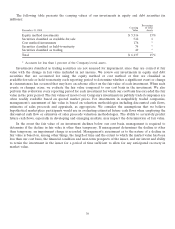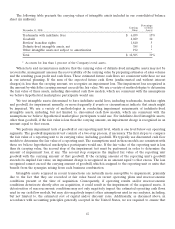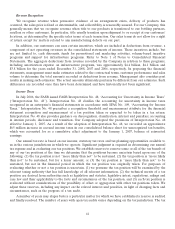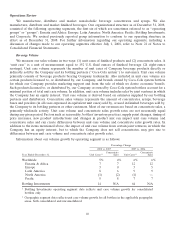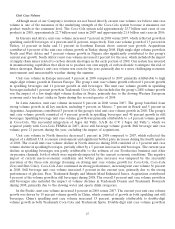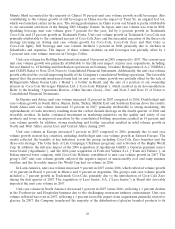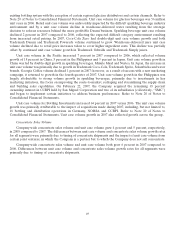Coca Cola 2008 Annual Report Download - page 49
Download and view the complete annual report
Please find page 49 of the 2008 Coca Cola annual report below. You can navigate through the pages in the report by either clicking on the pages listed below, or by using the keyword search tool below to find specific information within the annual report.Unit Case Volume
Although most of our Company’s revenues are not based directly on unit case volume, we believe unit case
volume is one of the measures of the underlying strength of the Coca-Cola system because it measures our
product trends at the consumer level. The Coca-Cola system sold approximately 23.7 billion unit cases of our
products in 2008, approximately 22.7 billion unit cases in 2007 and approximately 21.4 billion unit cases in 2006.
In Eurasia and Africa, unit case volume increased 7 percent in 2008 versus 2007, which reflected growth in
sparkling and still beverages of 4 percent and 21 percent, respectively. Unit case volume growth of 15 percent in
Turkey, 14 percent in India and 11 percent in Southern Eurasia drove current year growth. Acquisitions
contributed 6 percent of the unit case volume growth in Turkey during 2008. High single-digit volume growth in
North and West Africa and 7 percent volume growth in Nigeria also significantly contributed to the group’s
current year growth. South Africa’s unit case volume increased 1 percent for the year, which included the impact
of supply chain issues related to carbon dioxide shortages in the early portion of 2008. Our system has invested
in manufacturing capabilities that allow us to produce our own supply of carbon dioxide to mitigate the risk of
future shortages. Russia’s unit case volume was even for the year, primarily due to a more challenging economic
environment and unseasonable weather during the summer.
Unit case volume in Europe increased 3 percent in 2008 compared to 2007, primarily attributable to high
single-digit volume growth in Eastern Europe. The group’s unit case volume growth reflected 1 percent growth
in sparkling beverages and 11 percent growth in still beverages. The unit case volume growth in sparkling
beverages included 1 percent growth in Trademark Coca-Cola. Also included in the group’s 2008 volume growth
was the impact of a low single-digit volume decline in Iberia, primarily due to the slowing Western European
economy and a truckers’ strike in Spain during the second quarter of 2008.
In Latin America, unit case volume increased 8 percent in 2008 versus 2007. The group benefited from
strong volume growth in all key markets, including 9 percent in Mexico, 7 percent in Brazil and 5 percent in
Argentina. Acquisitions contributed 3 percent of the group’s total unit case volume growth in 2008. The group’s
unit case volume growth consisted of 4 percent growth in sparkling beverages and 40 percent growth in still
beverages. Sparkling beverage unit case volume growth was primarily attributable to a 4 percent volume growth
in Coca-Cola. The successful integration of Jugos del Valle, S.A.B. de C.V. (‘‘Jugos del Valle’’), which we
acquired jointly with Coca-Cola FEMSA in 2007, drove still beverage volume growth. Still beverage unit case
volume grew 21 percent during the year, excluding the impact of acquisitions.
Unit case volume in North America decreased 1 percent in 2008 compared to 2007, which reflected the
impact of a difficult U.S. economic environment and significant bottler price increases during the fourth quarter
of 2008. The overall unit case volume decline in North America during 2008 consisted of a 3 percent unit case
volume decline in sparkling beverages, partially offset by a 5 percent increase in still beverages. The current year
decline in sparkling beverages was partly attributable to the softness of our Foodservice business and other
on-premise channels, both of which were negatively impacted by the current economic conditions. The negative
impact of current macro-economic conditions and bottler price increases was tempered by the successful
execution of the three-cola strategy (focusing on driving unit case volume growth for Coca-Cola, Coca-Cola
Zero and Diet Coke). Coca-Cola Zero continued its strong performance, increasing unit case volume 36 percent
in 2008. Still beverage unit case volume increased 5 percent in the current year, primarily due to the strong
performance of glac´
eau, Fuze, Trademark Simply and Minute Maid Enhanced Juices. Acquisitions contributed
4 percent of the volume growth in still beverages during 2008. The overall 5 percent unit case volume growth in
still beverages also included the impact of volume declines in Trademark Dasani and Trademark Powerade
during 2008, primarily due to the slowing water and sports drink categories.
In the Pacific, unit case volume increased 8 percent in 2008 versus 2007. The current year unit case volume
growth was driven by 19 percent volume growth in China, which consisted of growth in both sparkling and still
beverages. China’s sparkling unit case volume increased 15 percent, primarily attributable to double-digit
volume growth in both Trademark Coca-Cola and Trademark Sprite. Double-digit unit case volume growth in
47




